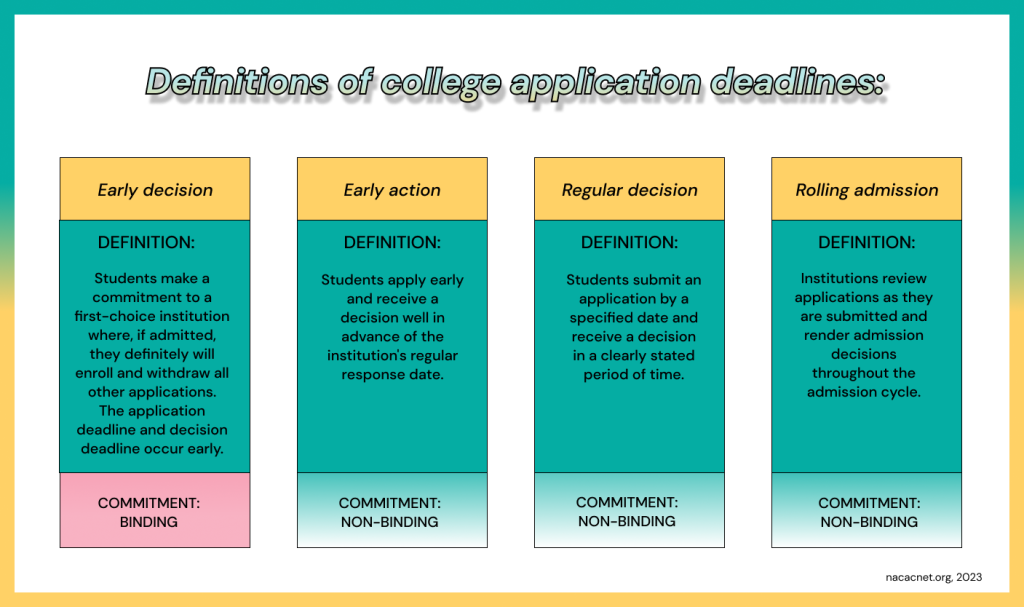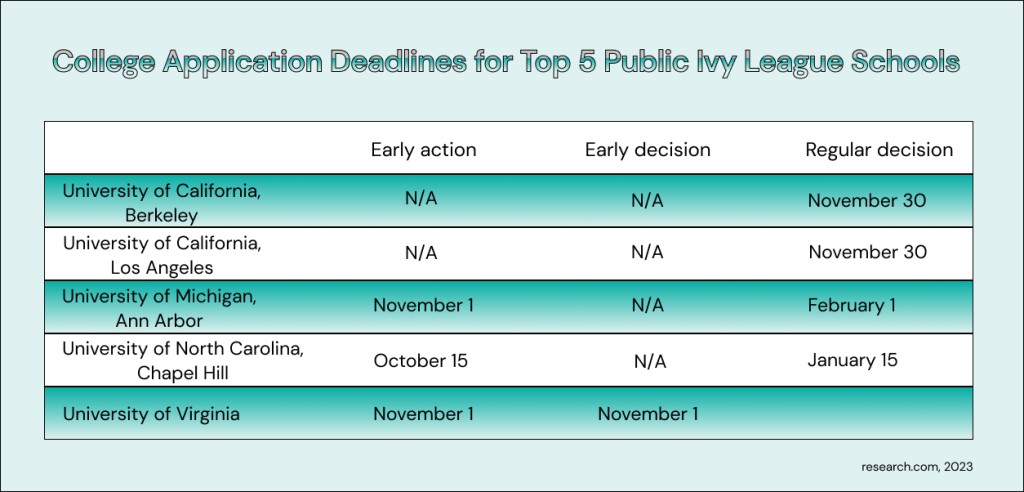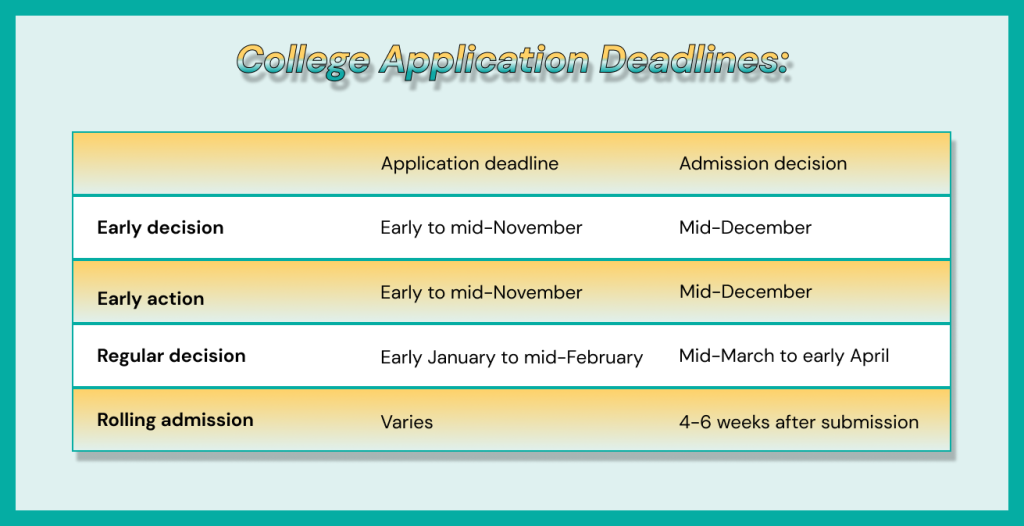Entering college is a turning point in young people’s lives. They have to choose the right institution that will allow them to master their future profession and build a successful career. This is not an easy task, and there are many big and small obstacles on the way to solving it. So, when planning to apply to a school, a student needs to have a clear understanding of when to do it, how to do it right, and what options they have. A college application deadline is a rather complicated topic with many nuances. Today, we will try to explain everything about it in detail.
Further in the article: |
Overview of College Application Deadlines
We know the college application timeline may seem overwhelming. That’s why we will tell you the most important things as simply as possible. So, to get into college, you need to send an application for admission. Most colleges and universities in the United States support four commonly accepted options for doing so:
- Early decision deadlines
- Early action deadlines
- Regular decision deadlines
- Rolling admission deadlines
Each of these options has its own peculiarities. We will analyze each of them.
Early Decision (ED) Deadline: Basics and Tips to Succeed
This option of applying for college admissions is extremely responsible. First and foremost, by submitting an application under this time slot, you commit to attending this school in case of a favorable admission decision. This means that even if you are accepted to any other college, you will have to refuse it and become a student of the college where you have submitted an early decision application.
In addition, this option does not allow you to find out about possible scholarships or other financial assistance from the university. This information will be disclosed upon enrollment.
This type of college application deadline is commonly divided into two sub-types: Early Decision I and Early Decision II.
- With Early Decision I, colleges finish accepting applications in early November. Expect a decision from the admissions office in mid-December.
- In the case of Early Decision II, schools stop accepting applications from mid-November to February. The college will send you an admission decision in the next two months.
Pros and cons you should consider
Pros | Cons |
|
|
Helpful tips on how to approach early decision deadlines
- Choose your school carefully. After weighing the pros and cons, apply to a college you are 100% sure about. Look for information about it, visit its campus and website.
- Plan for sufficient funding. Since you are accepting admission without knowing your financial aid options, you must be sure you can afford to pay for this college.
- Prepare an impeccable application. Colleges may enroll more students under this application option, but this does not mean they accept everyone without exception. There is competition, and you must make a great impression on the admissions committee. Make a compelling application that emphasizes your strengths.
Early Action (EA) Deadline: Useful Details You Should Know
This type of application is similar to the previous option, but the admission decision is not binding. This college application deadline window provides two big advantages: you get an admission decision before most students, and you don’t have to commit to the school. These advantages translate into another one. Since you receive a decision early enough and you are not obliged to enter this school, you can apply to other colleges and compare your options for college admissions. Under the early action deadline option, you must inform the school of your final decision by May 1 of the following year.
Common deadlines for the EA option are:
- The application process starts in early August and usually ends by mid-November.
- You can expect an admission decision in December.
Pros and cons you must be aware of
Pros | Cons |
|
|
Tips on how to succeed with the Early Action deadlines application
- Start your preparation early. Start working on your application well before the deadline. Be sure you have everything ready prior to the beginning of August. This will give you peace of mind and relief during the first months of your senior year.
- Stay focused and organized. The EA college application deadline period starts early enough. To meet all the requirements and prepare a convincing essay, spend your time wisely and in a balanced way.
- Ask for help. Do not think that the college application process is a one-person show. You may well ask for help and advice from your school counselor, teachers, and classmates.
Regular Decision (RD) Deadline: Essential Information to Consider
If you are a fan of the principle that “slow and steady wins the race,” this is the option for you. It falls at the end of the academic year, so you will have enough time to prepare all the necessary materials in the best possible way: your transcripts, good SAT/ACT results, and a flawless essay. It is worth noting that the regular decision deadline slot is the most popular option among students.
Typical regular decision deadlines are:
- Your applications must reach the college from early January to mid-February.
- You can expect your long-awaited college admissions decision in March or early April.
Pros and cons you should keep in mind
Pros | Cons |
|
|
Useful tips on how to approach the Regular Decision deadlines
- A smart use of time. You will have enough time to prepare a convincing college application. Try to use this time wisely.
- Think about your backup options. We know you dream of attending a particular college and can already imagine yourself there. However, life is full of surprises. Therefore, make sure you have several options to choose from if your target college rejects you.
- Be sure to prepare a persuasive and engaging essay. This part of your application can present you to the admissions committee in a new light. Try to put all your skills and reflect your personality in it.
Rolling Admission (RA) Deadline: Basic Information You Must Learn
This is a special kind of application deadline window. If you want to use this option, research the rolling admission deadlines of the schools you are interested in. They can vary dramatically between colleges. Typically, you can opt for this application deadline if you have not been successful with all others. Universities often use this option after the standard due dates to apply. Furthermore, schools can extend the rolling admission deadline up to August until all classes are filled according to the prerequisites.
Important pros and cons you should bear in mind
Pros | Cons |
|
|
Rolling admission deadline tips for you
- Trust verified sources. Before applying via the rolling admission deadline, check whether these educational institutions support it.
- Take the matter seriously. Only some universities continue to enroll students until August. You shouldn’t get your hopes up that all universities adhere to this policy.







